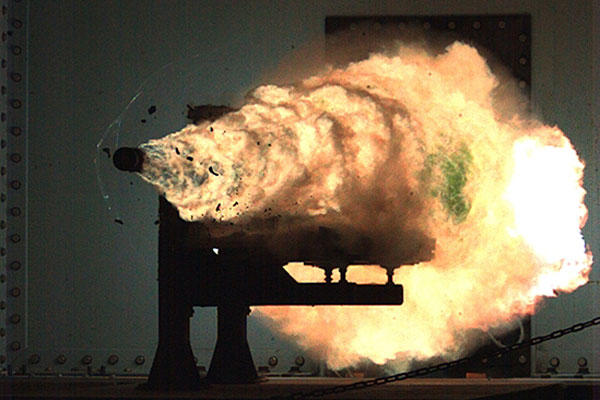The Navy will fire its electromagnetic railgun from a joint high speed vessel in 2016 as part of a broader effort to develop the long-range, high-energy weapon, service officials said.
The weapon will be placed on display this summer aboard the USNS Millinocket, a Navy JHSV which entered service in March. Following the display, the railgun will then be demonstrated on the same ship in 2016.
"We want to get this out on a ship and understand what lessons there are to learn," said Adm. Bryant Fuller, Chief Navy Engineer.
This move to test the weapon at sea, on a ship, marks the latest phase in the ongoing development of a new high-tech weapons system.
"We're talking about a projectile we're going to send well over 100 miles. We're talking about a projectile that can go over Mach 7. We're talking about a projectile that can go well into the atmosphere. We're talking about a gun that is going to shoot a projectile that is about one-one hundredth of the cost of an existing missile system today," said Adm. Matthew Klunder, Chief of Naval Research.
The railgun uses electrical energy to create a magnetic field and propel a 23-pound kinetic energy projectile at Mach 7.5 toward a wide range of targets, such as enemy vehicles, or cruise and ballistic missiles.
Due to its ability to reach speeds of up to 5,600 miles per hour, the hypervelocity projectile is engineered as a kinetic energy warhead, meaning no explosives are necessary, said Fuller and Klunder.
"You have 23 pounds going Mach 7, you don't necessarily need an explosive detonation to create damage," Fuller said.
However, different combinations of high-tech materials called energetics could be used to increase lethality or impact.
"We've done a number of models, and [the HVP warhead] gives us the ability to knock anything out of the air. We did lethality models on every single mission we have in the Marine Corps and the Navy. This could damage and be lethal in every occasion," Klunder added.
Although it has the ability to intercept cruise missiles, the 23-pound hypervelocity projectile can be stored in large numbers on ships. Unlike other larger missile systems designed for similar missions, the hypervelocity projectile costs only $25,000 per round.
The railgun can draw its power from an onboard electrical system or large battery, Fuller said. The system consists of five parts, including a launcher, energy storage system, a pulse-forming network, hypervelocity projectile and gun mount, he said.
"In 2016, we are going to bring all these pieces together on a ship and start learning what we can learn in a marine environment," said Fuller.
The gun is configured for single shots; however, officials hope the weapon will fire up to 10 rounds per minute, Fuller said. Firing multiple rounds per minute is part of the weapon system's ongoing phase two development.
BAE Systems was awarded a phase-two contract from the Navy last summer for the development of the railgun, but there are other vendors working on different aspects of the system.
Raytheon, General Atomics and BAE were all awarded development deals in 2012 from the Navy to develop a pulse-power system for launching projectiles in rapid succession -- to achieve a firing rate of six to 10 rounds per minute, said Peter Vietti, spokesman for the Office of Naval Research.
A number of different firing and guidance technologies are still being considered for the weapon, but Navy officials said the hyper-velocity projectile can use GPS guidance toward targets.
The electromagnetic railgun generates force equivalent to 32 megajoules. Fuller explained that one megajoule is equal to one ton traveling at 100 miles per hour.
"Like a freight train going through the wall at 100 miles per hour," Fuller added.
Fuller also said the software for the system is built with what he called open architecture, meaning the electromagnetic railgun could easily be configured for other ships in the future.
The upcoming demonstration on JHSV is the latest in a series of developmental initiatives with the railgun. The weapon has been tested and developed at the Naval Surface Warfare Center in Dahlgren, Va. Last December, the railgun fired eight shots at White Sands Missile Range, N.M., Klunder said.
Following these tests, Defense Department officials have considered additional applications for the railgun across the services.
In particular, if the high-speed kinetic energy interceptor can reach distances of 100 miles and succeed in destroying large missiles, then it could be used against missile threats outside or above the Earth's atmosphere. Therefore, it's possible the railgun could be useful for ballistic missile defense because experts explain the Earth's atmosphere extends roughly 60 miles above the surface.
Klunder said the weapon could have a huge effect as a deterrent.
"Now you've a hugely capable multi-mission gun that has a huge affordability component. I think it will give our adversaries a moment of pause to say ‘I do not even want to engage a Navy ship because I'm going to lose,' " Klunder said.




























